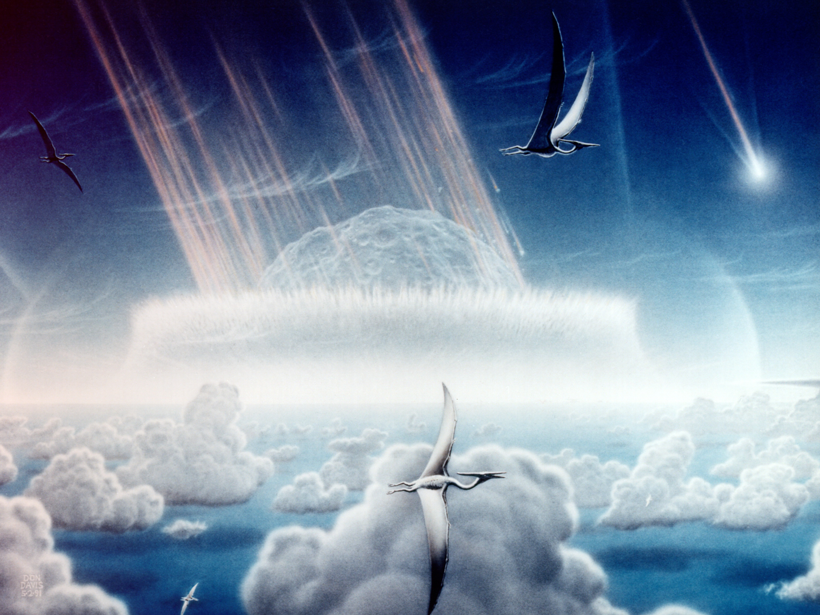
An argument millions of years in the making might finally be settled. Using climate and habitat modeling, researchers have found new evidence that an asteroid impact, not volcanism, likely caused the end Cretaceous extinction of nonavian dinosaurs. The asteroid strike—in the modern-day Yucatan Peninsula—was primarily responsible for the die-off, the team concluded, because it triggered a deadly “impact winter” that might have been more than 60°C colder than usual.
Debate of Two Cataclysms
What spelled the dinosaurs’ demise roughly 66 million years ago is one of science’s longest, and most acrimonious, debates. There’s excellent evidence for two separate cataclysms around the end of the Cretaceous: the Chicxulub asteroid impact and prodigious volcanism from the Deccan Traps. Both of these events likely disrupted ancient Earth’s climate, but in different ways, researchers agree.
There’s good motivation for this study, said Kunio Kaiho, a geologist at Tohoku University in Japan not involved in the research. All five major mass extinctions during the Phanerozoic have coincided with large volcanic eruptions, he said. “Researchers want to understand whether four mass extinctions were caused by volcanism and one is exceptional, or whether all five were caused by volcanism.”
Alfio Alessandro Chiarenza, a paleontologist at University College London, and his colleagues modeled the climatic effects of the volcano- and asteroid-induced cataclysms separately and in tandem. The researchers also used habitat suitability modeling to estimate how dinosaur habitat ranges would have been affected given the climatic conditions.
Dim and Cold
Chiarenza and his collaborators began by using a coupled atmosphere-ocean general circulation model to simulate the solar dimming caused by an asteroid impact. Impacts loft aerosol-producing gases and ash high into the atmosphere, where they act like tiny sunlight reflectors.Previous research has suggested that the Chicxulub asteroid impact dimmed incoming solar radiation by between 5% and 20%. Using these values, Chiarenza and his colleagues estimated that global mean surface temperatures decreased by between roughly 10°C and 70°C and took decades to return to normal values. They also found that solar dimming of 15% or above completely obliterated suitable habitats for dinosaurs.
“It would have been bad for everything,” said Chiarenza.
The team next used the same atmosphere-ocean general circulation model to simulate volcanism, specifically the monumental eruptions of the Deccan Traps. Volcanoes belch an amalgam of gases—some cause climate-cooling aerosols to form, but others linger in the atmosphere, where they act like greenhouse gases. The bigger the eruption is, the larger those belches are. And the Deccan Traps, in modern-day India, let loose some of the most impressive volcanism that the world has ever witnessed roughly 66 million years ago.Those eruptions pumped out millions of cubic kilometers of magma. (For comparison, the eruption of Mount St. Helens in Washington State in 1980 released approximately 1 cubic kilometer of magma.) Chiarenza put it in geographic perspective: “Imagine France made out of basaltic lava.”
Cooling and Warming of Volcanism
Chiarenza and his collaborators modeled several different eruption scenarios. (The amount and proportion of gases emitted by the Deccan Traps, as well as the duration of the eruptions, aren’t well constrained.)
The researchers found potential cooling of up to about 10°C, but equatorial regions of the planet would still have remained habitable, the team concluded. Warming of a few degrees Celsius was also possible as a result of the volcanism, Chiarenza and his colleagues found. Warming would have actually allowed the dinosaurs to expand their range, habitat modeling revealed.
The Chicxulub asteroid impact was therefore the likely death knell, the team concluded. “These results support the asteroid impact as the main driver of the non-avian dinosaur extinction,” the team concluded last month in the Proceedings of the National Academy of Sciences of the United States of America. That’s consistent with other recent findings.
However, volcanism might still have left an imprint on the extinction event, the researchers acknowledge. Carbon dioxide–induced warming could have mitigated some of the most deleterious effects of the asteroid impact, potentially reducing the severity of the extinction, said Chiarenza.
There’s another extinction worth studying, said Tohoku University’s Kaiho. It occurred 145 million years ago at the Jurassic-Cretaceous boundary. Just like the end Cretaceous extinction, there was a contemporaneous impact—it formed the 130-kilometer-diameter Morokweng crater in South Africa—but it’s not well understood, said Kaiho. “The relation between the impact and the mass extinction recorded at the Jurassic-Cretaceous boundary has not yet been clarified.”
—Katherine Kornei (@KatherineKornei), Science Writer
"impact" - Google News
July 21, 2020 at 07:25PM
https://ift.tt/3eMczJO
Asteroid Impact, Not Volcanism, Likely Spelled Dinosaurs' End - Eos
"impact" - Google News
https://ift.tt/2RIFll8
Shoes Man Tutorial
Pos News Update
Meme Update
Korean Entertainment News
Japan News Update
Bagikan Berita Ini














0 Response to "Asteroid Impact, Not Volcanism, Likely Spelled Dinosaurs' End - Eos"
Post a Comment